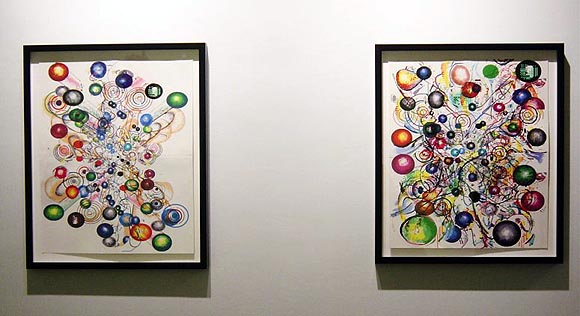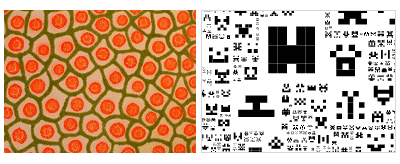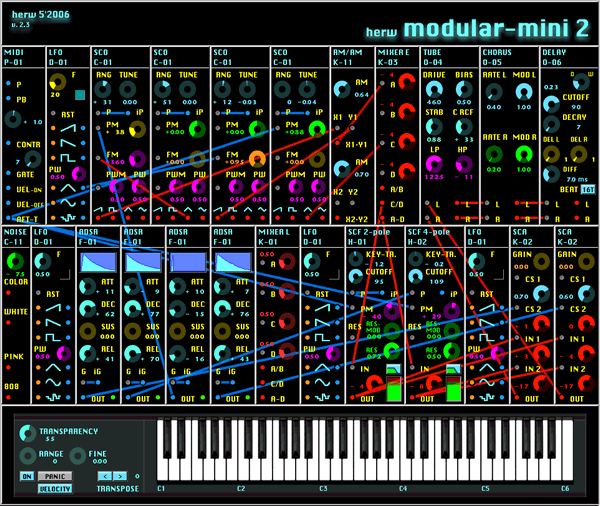View current page
...more recent posts
I've been going back over my YouTube posts from the past few months--a surprisingly large amount are dead links because they've been removed "for terms of service violations" or "by user." Read: people received greasy lawyer letters and got scared. As if some grainy, tiny crap video from the '70s is something anybody deserves to profit from. Amazing how many creative types don't get the viral thing at all.
Lke Anna Karina's Sweater on Oliver Stone's 9/11 movie:
While it is remarkable that anybody was found alive in [the World Trade Center] rubble (McLoughlin and Jimeno were 2 of only 20), I feel that there's something inherently irresponsible in narrowing the focus in order to create an uplifting, feel-good story. It's as if the film exists in a vacuum, and its refusal to acknowledge facts (both pre- and post-event) is not only naive, but also a bit dangerous. This kind of over-simplification is exactly how Bush & Co. would want you to remember that day. That it was simply an act of 'evil' carried out by individuals who hate our freedom. Is it any wonder that right-wing media outlets are praising the film, or that Paramount hired the same PR firm that brought us the Swift boat campaign against Kerry?Armond White weighs in, building up the Stone movie by bashing United 93:
After 9/11, hucksters have had a huge opportunity to trick filmgoers who are unable to distinguish the solemnity of recent history from tacky Hollywood manipulation. During United 93, when I laughed at its preponderance of action-movie cliches, a middle-class woman chided me to “Be respectful!” Respectful of what? Clumsy exploitation-film mechanics!

Animated GIF sketchbook, again
Animated GIFs (for eventual videos) based on time lapse documentation of the making of the above works (the animations are still sketches and will change somewhat):
Animated version of image on left (new): [2.7 MB .GIF]
Image on right (previously posted): [2.6 MB .GIF]

In David Szafranski's paintings, a group of which were linked to here, dataisnature sees some biological and mathematical underpinnings:
It’s the human equivalent of a Diffusion Aggregation Limitation system - whereby particles in solution diffuse randomly until they move near to a piece of solid structure, at which point they come out of solution and form part of the aggregate, resulting in dendritic structures. All of the works have a similar quality and evoke the idea of the human-computer in repetitive sub-routines crystallizing the work into existence.To illustrate the human-computer connection, DIN pairs a detail of a Szafranski painting with a section of a computer-generated drawing by Jared Tarbell (reproduced above). Continuing the conversation and emphasizing the links between "cyber" and "natural" diffusion models, Szafranski, no slouch in the computational department as well being a kick ass painter, has posted a seductive animated GIF [1 MB .GIF] that applies some of the principles of growth and space-filling DIN mentions.
The actual physical makeup of the paintings, though, in contrast to the ethereal GIF and DIN's elegant theory, suggests a more problematic relationship to science. Made of glue, spray paint, and modeling store synthetic grass, in semi-stable combinations certain to give art world painting fetishists fits, the canvases may evoke principles of fractal orderliness on a compositional level, but materially they revel in decay and punk anarchy: the mien of safety pins through the cheek rather than white lab coats.

Miyazaki Forest Spirits - Found GIF
Some thoughts on the amorphous middle ground between between the hissing, honking, and chittering of academic electronic music and the clicks, stabs, and skronks of its club-based variants.
Princeton professor and computer music pioneer Paul Lansky helped lay the groundwork for the economically thriving business of digital sound manipulation, which now includes the time stretching, spectral analysis, morphing techniques being routinely plied at software synthesizer companies like Steinberg and Native Instruments, as further hacked and jacked on thousands of home computer workstations. Lansky's essay The Importance of Being Digital could be a blueprint, or manifesto, for scenesters currently laboring in the trenches. Drawing on his own experience making music with mainframe computers in the '70s, Lansky presents the case for digital production with a theoretical heft usually lacking in chatboard discussions, which are mostly concerned with technical problem-solving: especially compelling is his consideration, based on film theory, of where sound is "located" and the fictions we accept as listeners. Lansky also shines in the studio: hear, for example, his "Night Traffic," 1990 (scroll down for excerpt), which digitally adds pitch and timbre information to the sounds of cars barreling hither and thither on a four lane highway, creating original, listenable music that is both powerful and oddly poignant. Lansky's gravitas and command of the Western tonal pallette puts this closer to the symphonic tradition than any one-off formal experiment.
For a "pop" mirror to Lansky's essay, consider the following review from amazon.com. The topic is the CD Columbia-Princeton Electronic Music Center 1961-1973. A reviewer obviously steeped in that electronic music that evolved out of the club scene--now a kind of parallel universe to the academic camp that is arguably just as vital (see previous posts on the music at Reaktions.com)--yells back across the wormhole to musicians of Lansky's generation who worked with Wollensak tape recorders and refrigerator-sized computers. The review merits sociological attention for the language accommodations the writer makes to explain the academy's music to his own tribe (or I should say, "our own")--mostly cheeky apologies but some deft rock-crit turns of phrase. Lansky, for his part, has made overtures to the popsters from his side of the wormhole, name-checking Autechre and Radiohead (the latter of whom sampled him).
OK, first off, these folks are writing art music, not pop. In fact, they're the folks who brought you "Who Cares If You Listen?" So it's their job not to sound dated, quaint, or collectible, even 30 years (and thousands of Dr. Sample units) later. How well did they do?Some additional thoughts here.
Well, the effect on a dance music-drenched listener like me is kinda like sensory deprivation but more fun. The reptile in my hindbrain hears the electronic tones and expects prominent beat, lots of repetition, and a climactic hook or two. When it fails to get what it expects it zones out, and lets me concentrate on more abstruse things like musical structure, drama, emotion, you know, all the edifying stuff.
All the tracks (sorry, compositions) have that Columbia-Princeton "sound" - sort of a silky, bubbly deluge of myriads of hand-spliced tape snippets and oscillator calibrations. You get the feeling there's a lot of complexity behind the scenes. Despite risk of extra-musical contamination, it's hard to resist looking in the back of the book to find out how they made these pieces.
My favorites follow, your mileage may vary. Charles Dodge's "The Earth's Magnetic Field" features geomagnetic data converted to pitches and sent through a comb filter (a.k.a. flanger with LFO turned off - think Skysaw). "Cortez" by Ingram Marshall is one of those "see how far you can get with one sample" exercises, in this case the syllable "Oh". I like the way things suddenly sweep into focus when the context is revealed. "Out Of Into" by Bulent Arel and Daria Semegen is the soundtrack to an animation, full of fun melodic lines and evocative, dancing timbres. Even my inner reptile liked it.
--John R. Hodgkinson
Jason Uechi's interview with Lansky from '95 (revived in response to this post--cool!) here.
Jacob Weisberg, writing in Slate:
The problem for the Democrats is that the anti-Lieberman insurgents go far beyond simply opposing Bush's faulty rationale for the war, his dishonest argumentation for it, and his incompetent execution of it. Many of them appear not to take the wider, global battle against Islamic fanaticism seriously. They see Iraq purely as a symptom of a cynical and politicized right-wing response to Sept. 11, as opposed to a tragic misstep in a bigger conflict. Substantively, this view indicates a fundamental misapprehension of the problem of terrorism. Politically, it points the way to perpetual Democratic defeat.The dispute here is not between war hawks and America-hating hippies with no grasp of geopolitics, and it's tiresome the way these "centrist" writers keep mischaracterizing the antiwar position. Surely it's a dispute over whether the "global battle against Islamic fanaticism" is a fought like a traditional World War II face-off among nation-states or some 4th Generation combo of politics, trade, cultural persuasion, and, when necessary, intelligently planned commando raids. Right now we're losing in both senses, not thanks to the antiwar movement but because Bush is out of his depth and screwing up massively. If we can't replace him, we need to tie his hands while he is in office, keep him from invading any more countries. Also, it's a dispute over whether pan-Islamic "fascism" is a real threat or just some propaganda shite Christopher Hitchens made up for Bush. Seems as if the "Islamics" do an awful lot of deadly fighting among themselves. On the military side, Steve Gilliard does an excellent job of putting the mushy Weisberg in his place.

New compositions on the Reaktions site, all made with versions of the HERW Modular-Mini synth--a user-built instrument in the Reaktor library. While all Reaktor synths are "modular" and "patchable" in the sense that you can go behind the interface and move parts and wires around, this one has virtual patchcords (and a keyboard) on the front. The look and sound recalls the old modular synths from the '60s and '70s, so not surprisingly the compilation has its nods to Wendy Carlos, Keith Emerson, and the Forbidden Planet score, all updated into the clean, infinitely tweakable digital environment. My favorite .mp3s are by chietronix, r.domain, Joe Risch, and herw (Herwig Krass) himself. The Reaktions group is a bit insular--many restrictions are put on the entries for these compilations, the main one being "made in Reaktor only." I suppose it's a way to really learn the instrument, but it's like Iron Chef having a "soft shell crab battle" where the only ingredient the chefs could use was soft shelled crab. Yes, one is a foodstuff and the other is a totalizing instrument, but while all-Reaktor compositions can be stimulating they frequently need something else.
An earlier report, on the Oki Computer 2 compilation, is here.
